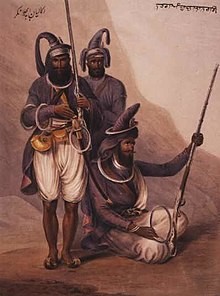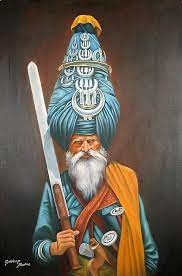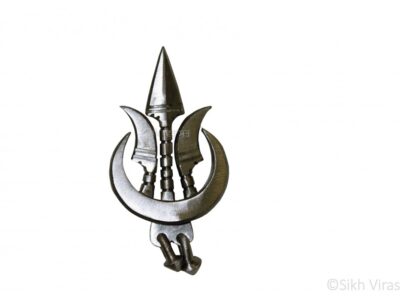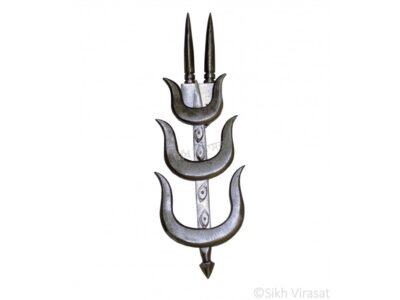Who Is Nihang Sikhs ?
The Nihang Sikhs are famous for their culture and their prestigious order of Sikh warriors, who are dressed in blue robes, ancient weapons and decorated turbans, which are topped by steel quotients. The meaning of the word Nihang is everlasting, uncontrollable. The Sanskrit word “Nihashank” means without fear. The order for the creation of the Khalsa can be traced back to 1699 by Guru Gobind Singh. They are noticeable wearing blue turbans, steel bangles, steel coats with knives and swords, and iron chains. Sikh military history was dominated by the Nihangs, who were known for their bravery and victories. 5 KS The Khalsa Panth was created by Guru Gobind Singh in 1699. Taken together, they symbolize that the Sikhs who wear them have dedicated themselves to a life of devotion and devotion to the Guru. These 5K’s have their own importance. Whoever adopts these symbols dedicates his life to the Guru.
The 5 Ks Worn By Sikhs Are:-
- Kesh (Uncut Hair)
- Kara (A Steel Bracelet)
- Kanga (A Wooden Comb)
- Kaccha (Cotton Underwear)
- Kirpan (Steel Sword)
The symbols have become more powerful with each passing year of Sikh history.
What Is The Role Of Nihang Sikhs In History?
Early Sikh military history was dominated by the Nihang. They differ from all other Sikhs. Nihangs were also called crocodiles. From the era of 1705 till the establishment of the Sikh Empire by Maharaja Ranjit Singh Ji Nihang played an important role in the Sikh army. They were known for their immortality and ruthlessness in the battle. Nihangs formed the irregular squad of a Sikh armed force under Maharaja Ranjit Singh Ji. Nihangs against large-scale attacks by the Mughals in the 18th century. In defending the Sikh group during the attack of Ahmed Shah Durrani (1748-67). The Nihangs have created great affection and respect among Sikhs as they have played a decisive role in Sikh history and Sikh military history particularly. Nihang’s recent activities are mostly ceremonial. The Sikh martial tradition for more than 300 years old. After 1849 their dominance decreased.

They have 5 Takht. The Panj Takht are special Gurudwaras that are the seat of authority in Sikhism:-
- Akal Takhat Amritsar
- Takhat Sri Patna Sahib
- Takhat Sir Kesgarh Sahib Near Chandigarh
- Takhat Sir Damdama Sahib Bathinda
- Takhat Sir Hazur Sahib Nanded
Who Created Nihangs?
Nihangs generally known as alkalis or alkalis Nihangs are depute as Guru’s beloved or “Guruji di laadli fauj” (the Guru’s favorite army). Their origin is associated with the founding of the ‘Khalsa Panth’ by the 10th Sikh Guru, Gobind Singh. They are known for their high turbans and for their extensive use of the chakram as all have seen in the Kesari movies. Nihangs are divided into several groups or sects each with its own cantonment but it is divided into two “dals” Buddha Dal and Taruna Dal, names were given to the two sections into which the ‘Khalsa’ army was divided in 1733.
Akali Phula Singh Nihang was an Akali Nihang Sikh leader. He was a saint soldier of the Khalsa Shaheedan Misl and head of the Budha Dal in the early 19th century. The Buddha Dal (army of the elders). He was also a senior general in the Sikh Khalsa Army and commander of the irregular Nihang of the army. warrior with high character. He was also known for his effort to maintain the values of Gurmat and the Khalsa Panth.


The Dal came into existence in 1734 The Taruna Dal is (the army of youth) dal was first commanded by Baba Deep Singh. The second was commanded by Bhai Karam Singh and Dharam Singh of Amritsar. The third was led by Bhai Binod Singh and his son Baba Kahn Singh.
A properly dressed Nihang stands out as a true son of the Guru. A view of Nihang in the 18th century when Dal Khalsa had just started wearing this traditional type of dress. Today, when the entire Nihangs community gets together in Anandpur Sahib with the courage enough to stand against any suppressing power.
An assembly of Nihangs at one place at a given time gives a beautiful view of their strength and power. It is like a great river that cannot be stopped. The river was started on the eve of Baisakhi in 1699 from Anandpur by the feats of Guru Gobind Singh Ji.
Arms And Attire


The Nihangs are known for their specific way of life. They said they had their own deras. The deras have weapons, licensed firearms, horses and usually, everyone undergoes marital training. They wear edged bracelets of iron around their wrists (kara) and quoits of steel (chakram) tied in their blue turbans, together with the dagger carried by all Sikhs (kirpan) and carried a Katar on the left side a large chakram around the neck and an iron chain. Nihangs Sikh uses 5 physical symbols of Sikhism. The Nishan Sahib carries a real view of Sikhism being in plain blue and bright yellow attire. Blue symbolizes courage, bravery and yellow in Sikh culture symbolize sacrifices and honor. There is a short story of this attire that, how this uniform came into force?
Sahibzada Fateh Singh was the fourth and youngest son of Guru Gobind Singh Ji. One day all three sons were practicing together and Baba Fateh Singh also wanted to play with them but their brothers said that you are too small. The young Sahibzada felt let down then he went inside and tied a turban of blue color as tall and pointed from the top and he put on a blue dress placed a chakram and adorned himself with a small khanda. On seeing his look so majestic Guru Gobind Singh Ji replied that it would be the dress of Nihangs, the rackless soldiers of the Sikh army. Guru Gobind Singh used to wear blue attire at the time of battle. They hoist a blue Nishan Sahib (Flag). Nihang Sikhs are different from other Sikhs as they use Blue Nishan Sahib and others use Saffron Nishan Sahib (Flag). Nihangs use the slogans ‘chhardi kala’ (forever in high spirits) and ‘tiar bar tiar’ (state of ever preparedness) for unforeseen events.
Uses Of Intoxicants
Some Nihangs groups or sects consume cannabis. The cannabis plant has been used as a drug for both recreational and entheogenic purposes and in various traditional medicines. This is mostly used recreationally or as a medicinal drug, although it may also be used for spiritual purposes. And their main drinks shardai or sharbati degh, a sacrament drink that contains ground almonds, cardamom seeds, poppy seeds, black pepper, rose petals, and melon seeds. They have been known to be traditional consumers of bhang or some other form of an intoxicant that is taken orally but not smoked.


Nihangs Training

Nihangs the Warrior Sikh was initially established to preserve and guard the Gurudwaras. It has been more than 300 years, they decided to live their life in devotion to their Guru, train in martial art gatka and help their community. The primary martial art is gatka that is performed in music during their ceremonies and festivals. They also show their horse-riding skills by riding astride two horses. They are known as military expertise. This style of art is taught at private Sikh schools where it’s an official subject. Every year in the month of March they celebrated Hola Mahalla a Sikh festival introduced by Guru Gobind Singh. On this occasion, they hold tournaments of military skills, including mock battles, horse riding skills and elephant and on foot in their typical customs and carrying a variety of traditional weapons and showing their skills by using them.
Conclusion
Today Nihangs are a small community. Nihang Sikhs are generally known for their bravery and victories in Sikh military history that how they fought for their Khalsa Panth. And how they became so famous for their own lifestyle, tradition, and for their attire. Now they have divided into two groups as we discussed earlier. now they all live in their own deras there they cultivate their agriculture fields for livelihood and some of them own their private schools and academies too. And they also gather in Anandpur Sahib (the birthplace of Khalsa) for festivals and other religious ceremonies.
Top 13 Interesting Facts About Nihang Sikh
Nihang wears miniature versions of five weapons (Pancha Shastra) in their turbans, were the chakram, the khanda (sword), the karud (dagger), the kirpan, and the tir (arrow).
Nihangs Sikhs who is married is given the charge of taking care of the deras while the others move around the state.
Nihang Sikhs use the technique of Jhatka is practiced by certain sects within Sikhism on certain religious events.
Guinness World record of Major Singh, a Nihang Sikh, whose 400-meter long turban weighs around 77 pounds.
The largest turban is made with 400 m (1,312 ft) of cloth and belongs to Major Singh.
Bhai Pritpal Singh, head granthi of Gurdwara Dukh Nivaran Sahib, said there are more than 30 factions of Nihangs in Punjab, big and small.
When the Khalsa army was divided into five battalions in 1734, a Nihang or Akali battalion was led by Baba Deep Singh Shaheed.
After the fifth guru, Guru Arjan Dev was killed by the Mughals, Guru Hargobind, his son, promulgated the idea of learning Gatka to fight oppression. In the 17th century, Guru Gobind Singh, known as the master of weaponry.
Gatka is the name of a Sikh martial art associated with the Sikhs of the Punjab who practice the martial art. It is a style of stick-fighting, with wooden sticks intended to simulate swords. The Punjabi name gatka refers to the wooden stick. This art is taught by teachers who are trained as Nihangs.
Baba Budha Ji started training the Sikh army and formerly called them the Akali Sena, also referred to as Budha Dal in Gatka.
The word Nihang is derived from the Sanskrit word Nishank, which means holy.
Guru Gobind Singh Ji had said that one Khalsa is equal to one hundred thousand, Nihang is Khalsa. All were Nihangs in Guru Gobind Singh’s army.
The Nihangs had a major role in protecting the Sikh sect after the fall of the first Sikh rule (1710–15) when the Mughal governors were killing the Sikhs and during the attack of the Afghan invader Ahmed Shah Durrani (1748–65).




